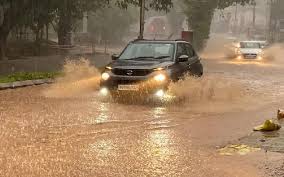Tamil Nadu, Kerala Rains Weather Forecast Today LIVE Updates: Heavy rain on the cards across southern India as IMD issues orange, red alerts

Southern India is facing intense rainfall as the southwest monsoon arrives early this year. The India Meteorological Department (IMD) has issued red alerts for many districts in Kerala and orange alerts for parts of Tamil Nadu. The rains have caused disruptions, raised landslide risks, and forced emergency responses across both states.
Early Monsoon Hits Hard
The monsoon usually enters in early June. But this year, it arrived ahead of schedule. Heavy rainfall has battered several parts of Kerala. Districts like Idukki, Ernakulam, Thrissur, Kozhikode, and Malappuram are under red alert. These areas may receive over 20 cm of rain in 24 hours. Other regions are under orange or yellow alerts for heavy showers and storms.
In Tamil Nadu, districts such as Kanyakumari, Tenkasi, Theni, and Tirunelveli have seen heavy rain. The IMD warned about strong winds, thunderstorms, and downpours. Gusts may reach up to 50 km/h.
Kerala: Schools Shut, Roads Submerged
Kerala’s rains have caused waterlogging, road damage, and landslide risks in hilly areas. Authorities declared holidays for schools and colleges in the affected districts. Officials also opened around 4,000 relief camps for displaced residents and those in high-risk areas.
Two teams from the National Disaster Response Force (NDRF) are already on-site. More teams are on standby. Fishermen have been asked to stay away from the sea. The Arabian Sea is expected to see waves up to 4 meters high. Boat services in Kerala’s backwaters have been suspended. Kochi and Kollam ports raised warning signals.
Tamil Nadu: Kanyakumari Faces Major Disruption
In Tamil Nadu, Kanyakumari has been hit hard. Uprooted trees, damaged power lines, and flooded farmland have caused concern. District Collector R. Alagumeena visited the worst-hit areas and supervised emergency work. Teams are clearing blocked roads and restoring electricity.
Temporary shelters have opened in schools and public buildings. They’re housing people from low-lying and flooded areas. Power cuts were reported in Tenkasi and Theni due to storm damage. Restoration efforts are ongoing despite weather challenges.
IMD Forecast: More Rain to Come
The IMD expects the heavy rain to continue until May 29. Kerala, Tamil Nadu, coastal Andhra Pradesh, and Karnataka will see more showers. Storms, lightning, and winds will increase the risk of accidents, landslides, and flash floods.
Hill regions like Idukki and Nilgiris face added risk. Authorities have advised residents to relocate if they live in landslide-prone zones.
Warming Oceans and Changing Weather
Meteorologists say warmer sea surface temperatures in the Arabian Sea are fueling these storms. Climate change is likely playing a role in the early and extreme arrival of the monsoon. Weather experts have noted an increase in unseasonal rains and shifting monsoon patterns across South Asia.
Such events show the need for better disaster planning and climate action. Without proper measures, extreme weather may become more common.
Safety Measures in Place
Governments in both states are urging people to stay indoors. Residents should avoid unnecessary travel, especially near rivers, slopes, or flooded roads. Emergency helplines—1070 for state-level help and 1077 for district-level—are available 24/7.
The IMD’s mobile app and website provide live weather updates. Officials recommend using these tools to stay safe.
Impact on Economy and Transport
The rains may affect farming in southern Tamil Nadu. Crops like bananas, rice, and vegetables are at risk from waterlogging. Farmers fear crop losses and reduced yields.
Travel has also been disrupted. Flights from Kochi and Thiruvananthapuram faced delays due to poor visibility. Buses and trains continue running in most places, but authorities are monitoring the situation.
A Wake-Up Call
The early and intense rains may offer relief from the summer heat. But they also serve as a reminder. Better city planning, early warning systems, and stronger disaster response teams are essential.
With red alerts in Kerala and orange alerts in Tamil Nadu, timely action has helped prevent major tragedies so far. Continued caution and cooperation can reduce further risks as the weather system unfolds.






